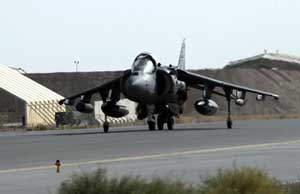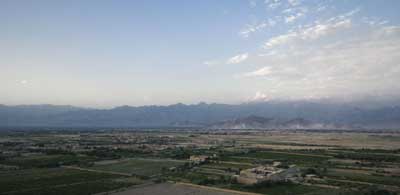by Fred Allison
“Everybody wanted to go”
Although a sizeable Army and coalition force inhabited the base at Bagram, the Marines were required to build their own camp and work spaces. So, as the VMA-513 pilots trained to fly and fight out of Bagram, an advance party, commanded by 1stLt Ryan P. Flanagan, composed of Marines from Marine wing support squadrons (included MWSS-373, 374 and 474) and Marine aviation logistics squadron 13 (MALS-13) flew a month early into Bagram to build the Marine camp. These Marines had a scant two weeks to get ready. Nevertheless, there was no shortage of volunteers, “everybody wanted to go.”
The advanced party arrived in Bagram in the middle of the night, forty Marines and about five C-5s loads worth of gear. The belly of the transport was blacked out as the Air Force transport banked hard into its spiraling, tactical approach descending down into Bagram. The Marines were in full combat gear with their personal weapons “locked and loaded.” After landing they stepped out into Bagram’s blackness, it was windy and raw cold. Building a base camp, or “tent city” fit easily within the capability of Marine wing support squadrons, which had the ability to build substantial expeditionary airfields if required. Nevertheless the Bagram experience was daunting.
The next morning they saw their campsite, frames of tents stuck in the “shin deep moon dust” was all that was there, and mines. The unexploded ordnance went first then they plunged into building their camp. After a month of 16 hour days, they had erected 30 strong back tents, each a home for eight Marines, laid gravel down, set up showers and a laundry, wired the camp for electricity and communications, built bunkers and put gates up. With no internal plumbing or sewage, water had to be hauled in and after use, the “gray water” was hauled out. Later they built a chapel, recreational facilities, a sand pit for martial arts training, a weight room/gym, bouldering wall, volleyball and basketball courts, and when a donated fiberglass above-ground swimming pool showed up they put that in too.[1]
Once the squadron had moved in, it was dubbed, “Teufel Hunden” (Devil Dog). In its center was a memorial to 9-11, miniature twin towers, which listed the names of fallen Marines in Afghanistan on a concrete pentagon base with an outline of the state of Pennsylvania, carved in the cement. A flagpole was set in the middle, where daily the national banner was raised and lowered.
They rarely had interaction with Afghan civilians, although some worked on base, hauling off the gray water and doing light construction work. There was also a Friday bazaar. Afghanis traveled for hours to sell their wares at the bazaar, antique firearms, jewelry, tapestry and furs. The VMA-513 Marines continued a time honored Marine tradition of promoting goodwill with the locals, especially the children. They visited Afghan children in the hospital; some were malnourished, others were victims of mines sown during the Soviet occupation and as a result had arms or legs missing. At Christmas the Marines conducted a ‘Toys for Tots’ campaign for Afghan children in surrounding villages. Donated toys came from the U.S., enough to fill two, five-ton trucks. They distributed them in town and outlying villages.
Logistics: Looking for Simplicity and Commonality
Squadron success hinged on aircraft maintenance, they only had six jets to support a demanding flight schedule and were on a long tether for replacement parts and other maintenance support. The MWSS and MALS-13 Marines made Bagram Harrier-friendly. They built a high-power turn up ramp for engine maintenance and operated a motorized sweeper – transported from CONUS to clean Bagram’s rugged surfaces. This combined with the pilots’ caution in taxiing and landing, takeoff procedures neutralized the FOD hazard evident in that they did not lose an engine from Afghanistan FOD in the year-long deployment.[2] This was an impressive record in light of the regularity of FODs at much “cleaner” CONUS bases.

Logistics to support the Harrier squadron in Afghanistan had been a major concern. To facilitate expeditionary aircraft maintenance, VMA-513 brought a Marine Corps-developed Remote Expeditionary Support Package a mini-maintenance department pack-up, van loaded for rapid deployment that gave VMA-513 a robust maintenance capability and a large degree of self-sufficiency despite the austere setting. They received some support from Army units on base and although the parts supply line extended back to home base, Yuma, Arizona, parts arrived timely most within five days, delivered mostly by commercial carriers and U.S. Air Force transports. Important for the high aircraft availability rate was the decision to bring only one variant of AV-8B, the night attack model, instead of the ‘radar’ variant too. This allowed for simplicity and commonality for parts supply, to include cannibalizing parts if the situation demanded.[3]
Marine mechanics endured the wind, dust, cold, heat and darkness of Bagram. Steeped security requirements required that they work “lights out” at night, they wore night vision goggles and used covert lighting unless they were in the “clamshell” hangar, a rapidly erected hangar set up by the Air Force. The maintainers worked long hours, 12-hour shifts, with a day off a distinct rarity; they did not mind since there was little else to do.
Lieutenant Colonel Dixon, attested to his Marines’ role in the success of the Bagram deployment, attested that through their “internal fortitude… working 12 on and 12 off, hot weather, cold weather, rain, sleet, snow or shine. These Marines can give, and give and give and don’t ask for much in return.” Marine mechanics produced a mission capable aircraft availability rate of 83% average, for the year’s deployment; no sortie was lost for factors they had control over.
Initially the deployment was to be only six months. About the time they should have been heading home the war in Iraq started. They had been pre-warned two months earlier, around Christmas, that they would be extended for six months, doubling their deployment time. They had been counting down the days. Dixon dreaded breaking the news to his Marines. Jokingly he said, “I made everybody turn in their weapons” before announcing the change. A year in Bagram was quite an experience.”
“Operation Forgotten Freedom”
Bagram sat in the middle of hostile territory, yet there was little actual fighting, although rockets or small arms fire occasionally arced in. Complacency and boredom threatened morale. Some Marines half joking called it “Operation Forgotten Freedom”. The Air Force rotated their Bagram A-10 squadrons in and out on a regular basis; about seven different A-10 squadrons came and went while the Flying Nightmares were there. Indeed many Marines who went to Iraq and fought in Operation Iraqi Freedom I were home before the VMA-513 Marines.

The outside threat kept them trapped on base. It was not unlike being on an aircraft carrier, but as one pilot remarked, “this carrier never pulls into port.”
After the squadron was extended Col Dixon implemented a rotational R&R program. All of his Marines had the opportunity to take a ten-day leave from Bagram. To pass the time, beyond working, which they did incessantly, the Marines PT’d. They got used to running with their M-16s. A Bagram marathon took place and documented in Runner’s World magazine. The internet, email and movies were available but, ever-innovative, flight line troops collected camel spiders, which, along with other “creepy crawlys” even cobras, inhabited the aircraft parking ramp and came out at night. Promising camel spiders were collected by Marine flight line troops to fight for the troops entertainment in the “battle dome” a plexi-glass box built by a Marine mechanic. Most important for morale, squadron leaders, and commanders up the chain of command—VMA-513 received visits from LtGen Earl Hailston, CG MarForPac and General Mike Hagee the Commandant—all stressed the significance of the deployment.
[1] VMA-513 Power Point brief, 2003, Reference Section, History Division, Quantico, VA.
[2] There was one engine damaged from “internal” FOD, a piece of the aircraft itself was ingested.
[3] Cannibalizing refers to the practice of taking a part from one aircraft and using it on another.
———-
***Posted January 4th, 2010


